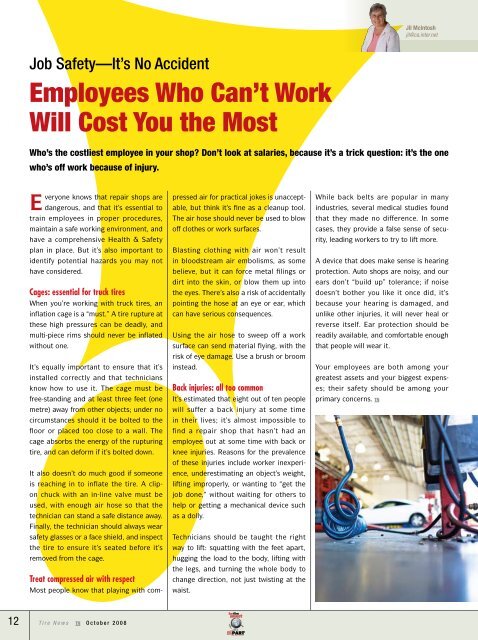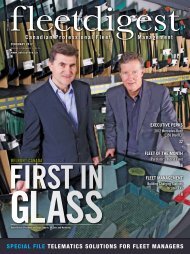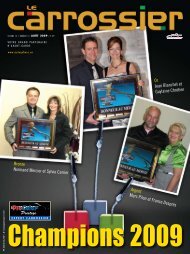Tire Dealers Association of Canada Convention - Autosphere
Tire Dealers Association of Canada Convention - Autosphere
Tire Dealers Association of Canada Convention - Autosphere
You also want an ePaper? Increase the reach of your titles
YUMPU automatically turns print PDFs into web optimized ePapers that Google loves.
Job Safety—It’s No accident<br />
Employees Who Can’t Work<br />
Will Cost you the Most<br />
Who’s the costliest employee in your shop? Don’t look at salaries, because it’s a trick question: it’s the one<br />
who’s <strong>of</strong>f work because <strong>of</strong> injury.<br />
Everyone knows that repair shops are<br />
dangerous, and that it’s essential to<br />
train employees in proper procedures,<br />
maintain a safe working environment, and<br />
have a comprehensive Health & Safety<br />
plan in place. But it’s also important to<br />
identify potential hazards you may not<br />
have considered.<br />
Cages: essential for truck tires<br />
When you’re working with truck tires, an<br />
inflation cage is a “must.” A tire rupture at<br />
these high pressures can be deadly, and<br />
multi-piece rims should never be inflated<br />
without one.<br />
It’s equally important to ensure that it’s<br />
installed correctly and that technicians<br />
know how to use it. The cage must be<br />
free-standing and at least three feet (one<br />
metre) away from other objects; under no<br />
circumstances should it be bolted to the<br />
floor or placed too close to a wall. The<br />
cage absorbs the energy <strong>of</strong> the rupturing<br />
tire, and can deform if it’s bolted down.<br />
It also doesn’t do much good if someone<br />
is reaching in to inflate the tire. A clipon<br />
chuck with an in-line valve must be<br />
used, with enough air hose so that the<br />
technician can stand a safe distance away.<br />
Finally, the technician should always wear<br />
safety glasses or a face shield, and inspect<br />
the tire to ensure it’s seated before it’s<br />
removed from the cage.<br />
Treat compressed air with respect<br />
Most people know that playing with com-<br />
12 <strong>Tire</strong> News tn October 2008<br />
pressed air for practical jokes is unacceptable,<br />
but think it’s fine as a cleanup tool.<br />
The air hose should never be used to blow<br />
<strong>of</strong>f clothes or work surfaces.<br />
Blasting clothing with air won’t result<br />
in bloodstream air embolisms, as some<br />
believe, but it can force metal filings or<br />
dirt into the skin, or blow them up into<br />
the eyes. There’s also a risk <strong>of</strong> accidentally<br />
pointing the hose at an eye or ear, which<br />
can have serious consequences.<br />
Using the air hose to sweep <strong>of</strong>f a work<br />
surface can send material flying, with the<br />
risk <strong>of</strong> eye damage. Use a brush or broom<br />
instead.<br />
Back injuries: all too common<br />
It’s estimated that eight out <strong>of</strong> ten people<br />
will suffer a back injury at some time<br />
in their lives; it’s almost impossible to<br />
find a repair shop that hasn’t had an<br />
employee out at some time with back or<br />
knee injuries. Reasons for the prevalence<br />
<strong>of</strong> these injuries include worker inexperience,<br />
underestimating an object’s weight,<br />
lifting improperly, or wanting to “get the<br />
job done,” without waiting for others to<br />
help or getting a mechanical device such<br />
as a dolly.<br />
Technicians should be taught the right<br />
way to lift: squatting with the feet apart,<br />
hugging the load to the body, lifting with<br />
the legs, and turning the whole body to<br />
change direction, not just twisting at the<br />
waist.<br />
Jil McIntosh<br />
jil@ca.inter.net<br />
While back belts are popular in many<br />
industries, several medical studies found<br />
that they made no difference. In some<br />
cases, they provide a false sense <strong>of</strong> security,<br />
leading workers to try to lift more.<br />
A device that does make sense is hearing<br />
protection. Auto shops are noisy, and our<br />
ears don’t “build up” tolerance; if noise<br />
doesn’t bother you like it once did, it’s<br />
because your hearing is damaged, and<br />
unlike other injuries, it will never heal or<br />
reverse itself. Ear protection should be<br />
readily available, and comfortable enough<br />
that people will wear it.<br />
Your employees are both among your<br />
greatest assets and your biggest expenses;<br />
their safety should be among your<br />
primary concerns. tn






